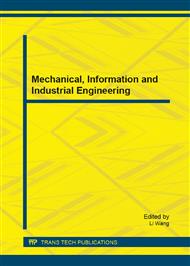p.150
p.154
p.161
p.165
p.171
p.175
p.180
p.186
p.191
The Structure Design of Gait Pole Climbing Robot
Abstract:
The theory of gait is one of walking ways which is efficient, fast and stable in a variety of industrial robots, offering a structure of climbing robots in a way of gait and climbing with the gait motion in paper. Through the results of analysis by various industrial software, the presented structure of climbing robots which is composed of two terminal parts and two robot arms that is the part of pedestal and climbing mechanism. In the process of climbing, realizing gripping, Swing work, turning work, an orderly motion and get to the aimed place finally through alternate between the upper and lower part of the body by the control of SCM. The presented method has not only improved many problems like complicated climbing structure, controlling rough, slow-motion and unable thronging obstacles, but also accomplished the subsequent operations like tools delivering, pole testing, clearing, maintenance work, furthermore, there has more comprehensive benefits.
Info:
Periodical:
Pages:
171-174
Citation:
Online since:
March 2015
Authors:
Price:
Сopyright:
© 2015 Trans Tech Publications Ltd. All Rights Reserved
Share:
Citation:


